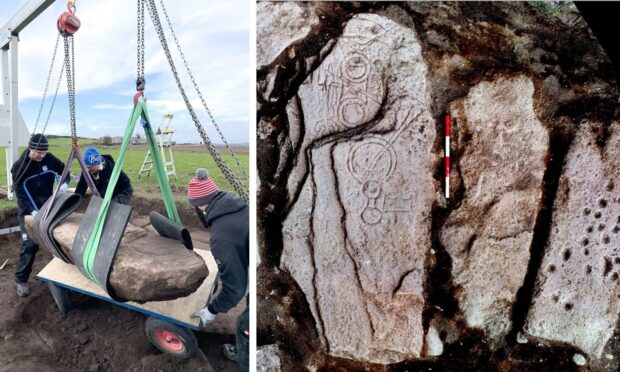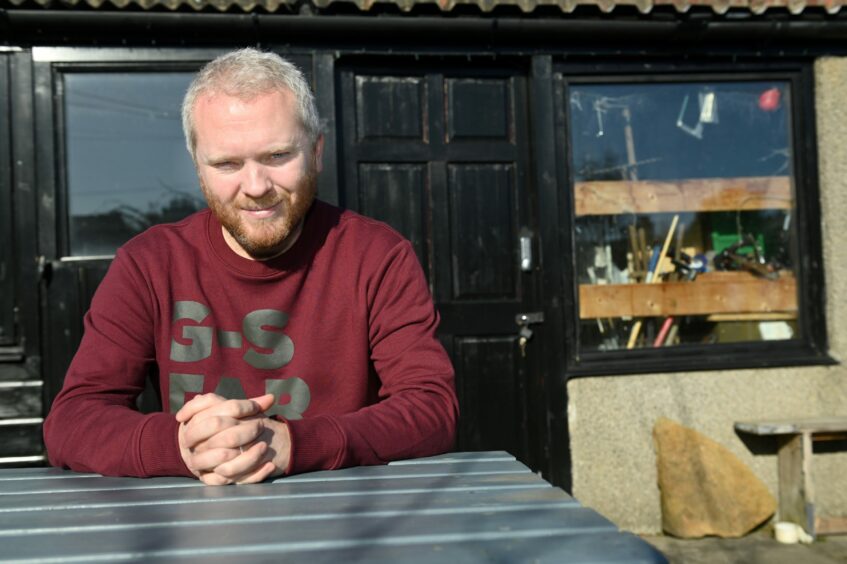Archaeologists have uncovered a rare Pictish symbol stone near the site of a famous battle.
The team from the University of Aberdeen hit upon the 1.7m-long stone in a farmer’s field while conducting geophysical surveys.
In trying to build a greater understanding of the important Pictish landscape of Aberlemno, near Forfar, they found something of even more significance.
Aberlemno is already well-known for its Pictish heritage thanks to its collection of unique Pictish standing stones.
One of these, a cross-slab thought to depict scenes from the Battle of Nechtansmere, is one of the most significant carved stone monuments ever uncovered in Scotland.
The Battle of Nechtansmere was of vital importance to the creation of what would become Scotland.
Pictish stone one of only 200 known
During work with imaging equipment which began in early 2020, the archaeologists found anomalies which looked like evidence of a settlement.
A small test pit was dug to see whether the remains of any buildings might be present. To their surprise, the team came straight down onto a carved Pictish symbol stone, one of only around 200 known.
Covid lockdowns hindered their efforts to establish the character of the stone and settlement. It was several months before they were able to return to verify their find.
The team think the stone dates to around the fifth or sixth century and, over the last few weeks, they have painstakingly excavated part of the settlement and removed it from its resting place – finding out more about the stone and its setting.
‘None of us could quite believe our luck’
Professor Gordon Noble, who leads the project, said stumbling upon a stone as part of an archaeological dig is very unusual.
“Here at the University of Aberdeen we’ve been leading Pictish research for the last decade. But none of us have ever found a symbol stone before,” he said.
“There are only around 200 of these monuments known. They are occasionally dug up by farmers ploughing fields or during the course of road building. But by the time we get to analyse them, much of what surrounds them has already been disturbed.
“To come across something like this while digging one small test pit is absolutely remarkable. None of us could quite believe our luck.”
Screaming, more screaming, crying: A ‘never again’ find
The research team won a prestigious national award last year for their work in transforming our knowledge of the Picts.
It was research fellow Dr James O’Driscoll who first discovered the stone.
Describing the excitement, he said: “We thought we’d just uncover a little bit more before we headed off for the day.
“We suddenly saw a symbol. There was lots of screaming. Then we found more symbols and there was more screaming and a little bit of crying!
“It’s a feeling that I’ll probably never have again on an archaeological site. It’s a find of that scale.”
Like the other stones at Aberlemno, the new discovery appears to be intricately carved with evidence of classic abstract Pictish symbols including triple ovals, a comb and mirror, a crescent and V-rod and double discs. Unusually, the stone appears to show different periods of carving with symbols overlying one another.
Stone off for further study before being displayed
The stone has now been moved to the Graciela Ainsworth conservation lab in Edinburgh where more detailed analysis will take place.
Professor Noble hopes that it could make a significant contribution to understanding the significance of Aberlemno to the Picts.
Researchers will now be working with the Pictish Arts Society to develop a fundraising campaign for the conservation and display of the stone.
More from the Schools and Family team
‘Evil cannot prevail’: Aberdeen students protest Russian invasion of Ukraine
Talking to kids about Ukraine: How to handle a worrying topic











